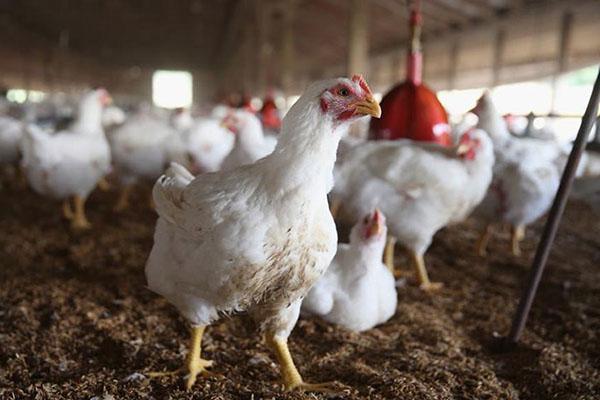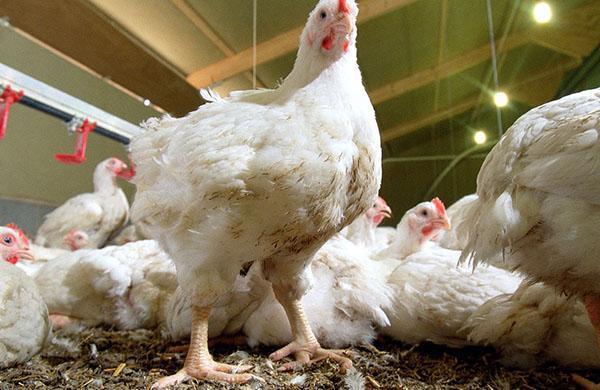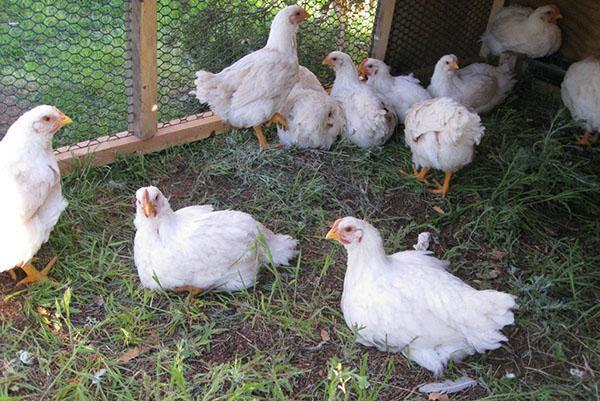Breeding, care and feeding of broiler chickens
 Speaking of broilers, we mean meat-based chickens, characterized by high growth rates, large size and excellent meat suitable for frying.
Speaking of broilers, we mean meat-based chickens, characterized by high growth rates, large size and excellent meat suitable for frying.
An increasing number of poultry farmers are interested in how to organize the raising, care and feeding of broiler chickens. And this is not surprising at all.
In just 7–8 weeks, the bird grows to 1.5–2.5 kg, which, with the right approach, during the warm season, even in a small farm, makes it possible to grow 1–2 batches of chickens.
Features of growing broiler chickens

When raising broiler chickens, the focus of the poultry farmer is poultry care and feeding. Both must be adjusted from the first day of the chicks' stay on the farm, since delay often becomes the cause, if not death, then the weakening, stunting and painfulness of the livestock.
In the conditions of a backyard, broilers are settled in poultry houses on deep litter or cage keeping is used.
In the first case, the broiler room should be protected from external weather factors, and the floors should be warm and dry. It is most convenient to use sawdust as a bedding, which is well dried beforehand. Other materials can be used to ensure that the flooring is always dry, clean and loose.
Before settling chicks:
- cleaning, disinfection and drying of the poultry house;
- the floor is covered with a layer of slaked lime at the rate of 0.5–1.0 kg per square meter;
- on top of it, sawdust is poured with a layer of up to 10 cm;
- create conditions for maintaining air humidity at the level of 60–65%;
- provide constant ventilation of the room;
- maintain an air temperature of 26 ° C;
- provide round-the-clock lighting for day-old chicks.
With this method of growing broiler chickens, there should be no more than 12-18 birds per square meter.
While broilers are small and their own thermoregulation is imperfect, they need an elevated air temperature of 26–33 ° C. After 20 days, the air in the house can be cooled to 18–19 ° C. At the same time, it is important to ensure that the bird is comfortable, otherwise both too cold and excessively warm air negatively affects the growth and well-being of the chicks. Neglecting the rules of keeping poultry threatens to become familiar with the symptoms of diseases of broiler chickens and to treat a poorly growing flock.
 Growing in cages, especially of a multi-tiered structure, can significantly save the area of the house, simplify its hygienic processing and control the feeding of chicks. At the same time, the temperature and humidity conditions, as well as the average daily feed consumption rates, are similar to the content on the litter.
Growing in cages, especially of a multi-tiered structure, can significantly save the area of the house, simplify its hygienic processing and control the feeding of chicks. At the same time, the temperature and humidity conditions, as well as the average daily feed consumption rates, are similar to the content on the litter.
The rearing, care and feeding of broiler chicks is greatly influenced by the lighting of the cages or house. During daylight hours, the bird actively feeds and moves.The darker the room, the more sluggish the chicks grow.
Therefore, within 14 days from the moment of birth, round-the-clock lighting is organized for the chicks, and then they gradually switch to the natural regime.
Feeding broiler chickens at home
 However, it is not enough to create suitable conditions for the chickens and provide them with the proper amount of feed. To get large, well-fed poultry as soon as possible, it is important to choose a balanced, age-oriented diet.
However, it is not enough to create suitable conditions for the chickens and provide them with the proper amount of feed. To get large, well-fed poultry as soon as possible, it is important to choose a balanced, age-oriented diet.
How to feed broiler chickens? This question is the most relevant for all beginner and experienced poultry farmers who have not previously encountered the cultivation of such a bird. In household plots, they often use their own wet and dry feed.
The first weeks of the chicks' stay in the courtyard, they are fed with moist mashmongers based on boiled eggs, millet, crushed oats and wheat, which make up a little more than half of the total amount of feed consumed. From 3 weeks of age, boiled potatoes, replacing them with no more than a fifth of the grain.
 We must not forget about protein feeds, which lay the active growth of muscle and bone mass. For this purpose, the bird is given cottage cheese, yogurt, reverse and other dairy products. Fish and meat-and-bone meal becomes a source of animal protein from 10 days of age. These products should be given at first 5-7 grams per day per head, and then double the consumption.
We must not forget about protein feeds, which lay the active growth of muscle and bone mass. For this purpose, the bird is given cottage cheese, yogurt, reverse and other dairy products. Fish and meat-and-bone meal becomes a source of animal protein from 10 days of age. These products should be given at first 5-7 grams per day per head, and then double the consumption.
Feeding broiler chickens at home involves the use of protein-rich plant products, including sunflower cake, all kinds of meal, crushed legume seeds.
 From three days of age, green feed for broiler chicks is needed. In the spring and summer, this is a succulent grass, tops of garden crops, chopped carrot 3-5 grams per chicken. In the cold period, when there is not enough fresh herbs, grass flour no more than 2–5 grams and sprouts of barley or other cereals are introduced into the diet.
From three days of age, green feed for broiler chicks is needed. In the spring and summer, this is a succulent grass, tops of garden crops, chopped carrot 3-5 grams per chicken. In the cold period, when there is not enough fresh herbs, grass flour no more than 2–5 grams and sprouts of barley or other cereals are introduced into the diet.
An excess of grass meal in the feed can cause diarrhea in broiler chickens, the treatment of which implies a mandatory correction of the menu, the use of antibiotics and other drugs.
To prevent digestive problems, broilers are given:
- every other day, as a drink, a pink solution of potassium permanganate;
- fine gravel with a diameter of no more than 5 mm, which activates the intestines and improves the digestion of grain and other feed for broiler chickens.
From 5 days, the bird is given a crushed shell, but not sand, and chalk at the rate of 2-3 grams per chick. Mineral feed and gravel are not mixed with other components of the diet and are poured into separate containers that are constantly in the house.
 Clean water at room temperature should be maintained throughout the house. To exclude the development of pathogenic flora and the development of intestinal and other infections, the dishes are regularly washed and disinfected.
Clean water at room temperature should be maintained throughout the house. To exclude the development of pathogenic flora and the development of intestinal and other infections, the dishes are regularly washed and disinfected.
For better growth and as a preventive measure, at the first symptoms and treatment of diseases of broiler chickens, young chickens are given vitamin supplements. Already from the fifth day on the menu, they practice the use of oil solutions of vitamins A, D, and E, preventing an overdose of the drugs used.
 How many times a day and how to feed broiler chicks at home? The bird should not be deficient in food throughout its life. For the first 7 days, chicks should receive feed at least 8 times a day, then the bird is fed every four hours. In the third week, the number of meals is brought to four, and from the age of one month, broilers are fed in the morning and evening.
How many times a day and how to feed broiler chicks at home? The bird should not be deficient in food throughout its life. For the first 7 days, chicks should receive feed at least 8 times a day, then the bird is fed every four hours. In the third week, the number of meals is brought to four, and from the age of one month, broilers are fed in the morning and evening.
All wet feeds for broiler chickens are prepared so that they are eaten within 30-40 minutes by the bird.
If the mash is kept warm longer, it is possible:
- souring of products;
- insemination with insect eggs;
- development of pathogenic microflora.
All of these factors are most often the cause of diarrhea in broiler chickens, the treatment of which weakens the population and slows down the growth rate.
The use of compound feed for broiler chickens
 To intensify weight gain, today they use ready-made and homemade compound feeds that fully meet the physiological needs of the bird. This diet gives especially good results in the first four weeks.
To intensify weight gain, today they use ready-made and homemade compound feeds that fully meet the physiological needs of the bird. This diet gives especially good results in the first four weeks.
Finished broiler chicken feeds vary in particle size and composition. Most often, they resort to a three-stage feed system, which is designed for all ages of chickens from birth to slaughter.
While these mixes are more expensive than homemade mash, they significantly improve the performance of the growing population, make it easier to care for, raise and feed broiler chicks, and control food intake.
 At the initial stage, the compound feed helps to strengthen the immune system, to create all the prerequisites for good health and rapid growth of the bird. For this purpose, the amount of mineral supplements in the diet increases, the diet is based on easily arranged components.
At the initial stage, the compound feed helps to strengthen the immune system, to create all the prerequisites for good health and rapid growth of the bird. For this purpose, the amount of mineral supplements in the diet increases, the diet is based on easily arranged components.
During active growth, broiler chicken feed is a source of protein, calcium, vitamins and fats, which ensure rapid bone growth and muscle growth. Finishing mixtures are used before slaughter to increase body condition.
Growing broiler chickens in cages - video
Part 1
Part 2
Part 3
Part 4
Part 5
Part 6